Tagged With ‘cedar’
Edition Perfumes
On the Road
26 November, 2015
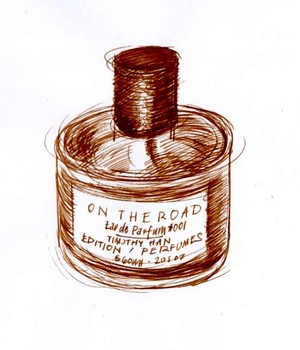 Since it was published in 1957, Jack Kerouac’s amphetamine-fuelled road-and-head-trip of a novel has inspired generations of would-be counter-culturalists to take off into the unknown, but until now, it has never inspired a perfume.
Since it was published in 1957, Jack Kerouac’s amphetamine-fuelled road-and-head-trip of a novel has inspired generations of would-be counter-culturalists to take off into the unknown, but until now, it has never inspired a perfume.
On the Road is only the second scent from East London-based Edition Perfumes, aka perfumer Timothy Han, but it follows in the literary footsteps of his first fragrance, She Came to Stay. Inspired by Simone de Beauvoir’s 1943 novel L’Invitée, She Came to Stay went on to be a best-seller for legendary London fashion boutique Browns.
Taking the plotline of Kerouac’s novel as its starting point, On the Road is one of those rare things in contemporary fragrance: a scent whose story unfolds on the skin – unlike so many recent perfumes, which continue to smell boringly identical from first spritz to final dreary gasp.
As Han describes his perfume, ‘it begins with smoky notes of benzoin and birch reminiscent of the hot asphalt and grittiness of New York City. Punctuated by forays into tobacco-filled bars where a new era in music is being defined by the jazz greats, our journey takes us through the openness of the dusty cornfields of a Mid-Western America and rises to the cedar forests of a Pacific Coast. The restlessness of the journey finally gives way to the optimism left by the fresh green fragrance of galbanum, citrus and bergamot.’
That is quite a lot to squeeze in to a 60ml bottle of perfume, but what we like about On the Road is that it really does develop in the hours after first spraying it on your wrist. Its initial burst of smoke and whisky gradually evolves into a very pleasing, long-lasting woody vetiver. It’s a fine piece of work, and all the more impressive given the quality of the design and packaging – though perhaps that’s less surprising once you learn that Han started his career as an assistant to John Galliano.
Though Han develops and makes his fragrances in his Dalston studio himself, he sees his work very much as a collaborative effort, and for On the Road he’s keen to mention hot young chefs Olia Hercules and Oliver Rowe, Hixter bartender James Randall and model Olivia Inge, without whom its launch, in Han’s words, ‘would have been a no-go’.
But perhaps the biggest shout should go out to the ebullient London artist Cedric Christie, whose photographs from a train trip he took from New Orleans to New York add an authentically On the Road-ish touch to the perfume boxes. Buyers get to choose from five different pictures, adding an extra layer of depth and desirability to the scent. All in all it’s a great launch, and I’m very much looking forward to Timothy Han’s next novel in a bottle.
Christian Dior
Jules
21 August, 2015
 Sage isn’t everyone’s favourite herb, though turkey stuffing wouldn’t the same without it. It’s used less often in perfumery than in cooking, but Jules shows what a great ingredient it can be in the hands of a brilliant perfumer.
Sage isn’t everyone’s favourite herb, though turkey stuffing wouldn’t the same without it. It’s used less often in perfumery than in cooking, but Jules shows what a great ingredient it can be in the hands of a brilliant perfumer.
The ‘nose’ in this case was Jean Martel, who worked for the French fragrance company Givaudan in the 1970s and 1980s and deserves to be far better known, not least because he also created that 1970s classic, Paco Rabanne for Men.
Jules was launched in 1980, with a brilliant advertising campaign featuring posters by René Gruau, arguably the greatest fashion illustrator of the last century, which helped the first bottles sell out in record time. Martel combined sage (which has a slightly catty smell) with cedar and other things like wormwood, lavender and bergamot. To me the result smells like sage and slightly peppery leather, though there’s a long list of other ingredients, including cumin, sandalwood, oakmoss, jasmine, musk and rose.
Despite its initial success, Jules has since been overshadowed by the success of Kouros, which was launched the following year. Created for Yves Saint Laurent by the brilliant Pierre (Cool Water) Bourdon, Kouros shares Jules’ clean / dirty / sexy character, and both scents belong to the same fragrance ‘family’, the fougères – a style of perfumes, usually aimed at men, based on a combination of lavender and coumarin (originally derived from tonka beans but usually synthesised).
Of course, Kouros’ ongoing popularity may be because it’s inherently superior to Jules, but actually I think it’s more to do with the fact that over the years Kouros has benefited from regular advertising, while Dior seems to have forgotten that Jules ever existed, which I think is a terrible shame.
To make matters worse, while you can buy Kouros pretty much anywhere, Jules has become ridiculously hard to find: I don’t know anywhere in the UK that sells it, and even in Paris the only place that seems to stock it is the department store Bon Marché, though you can buy it from Dior’s French website. Given Dior’s apparent lack of interest, it’s a wonder it hasn’t been discontinued, but I’m glad it’s still on sale, even if it’s now a rarity.
I can only hope that one day they decide to invest in promoting it again and making it available to all – but in the meantime if you want something special that very few other people will have, get over to Bon Marché.
Ramón Monegal
Dry Wood
2 March, 2015
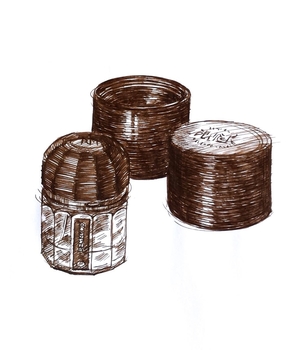 The world of perfume is full of great stories – some of them true, others completely bogus or quietly tweaked by fiendish marketeers. The story of Ramón Monegal is one of the better ones, and it’s also more interesting than most. The nice thing is that it has a happy ending too.
The world of perfume is full of great stories – some of them true, others completely bogus or quietly tweaked by fiendish marketeers. The story of Ramón Monegal is one of the better ones, and it’s also more interesting than most. The nice thing is that it has a happy ending too.
Monegal’s great-grandfather founded Myrurgia, which during the twentieth century became the best-known perfume brand in Spain. Ramón joined the business in 1972, training at Firmenich in Geneva and in Paris with the famous perfumer Pierre Bourdon (creator of Davidoff’s Cool Water and Serge Lutens’ Feminité du Bois).
Ramón created his first perfume for Myrurgia in 1979, but he also went on to develop scents for other brands, from Adolfo Dominguez to Inès de la Fressange. He eventually became vice-president of the family company, but in 2000 it was sold to Puig, the giant Barcelona-based fragrance-and-fashion group, which owns everything from Jean-Paul Gaultier to Penhaligon’s and L’Artisan Parfumeur.
The transition from owner to employee is surely always a difficult one, and though Monegal was appointed development director for the group’s fragrance brands, it must have hurt when, in 2007, Puig closed Myrurgia down. Monegal left the same year, but in 2010 he launched his own brand, and in 2014 he made a remarkable comeback by releasing fourteen new fragrances in one go. All the ones I’ve smelled so far are interesting and unusual, and Dry Wood is no exception.
It’s been described as a ‘sharp sandalwood’, but it also reminds me of a top-quality men’s aftershave from the 1970s, with hints of cedar and pine as well as sandalwood; if you remember the old ‘things happen after a Badedas bath’ adverts you’ll know the kind of thing I mean. It has great staying-power, and after a while smells woodier than it does to start with, though still with a touch of pine and turpentine.
Like all the perfumes in the range, Dry Wood comes in attractively luxurious packaging, also designed by Monegal. The chunky twelve-sided ‘inkwell’ bottles, with their flip-up black domed caps, are apparently inspired by his love of literature, and are contained in black Bakelite tubes, which screw closed in a very satisfying way. Perhaps it’s not surprising that these perfumes are expensive, at £130 for just 50ml (or $160 in the States).
The only problem at the moment is buying them: currently they’re only available from Harrods in the UK or Nieman Marcus in the US, which means they’re not going to get as wide an exposure as I think they deserve. Still, they’re well worth tracking down if you have the dedication (and the cash).
Geoffrey Beene
Grey Flannel
23 February, 2015
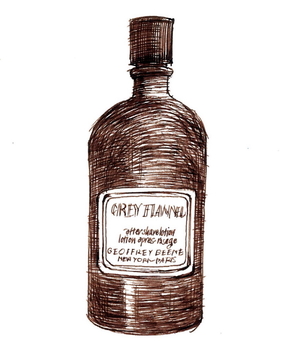 The American fashion designer Geoffrey Beene died of cancer in 2004, but Grey Flannel, the perfume he commissioned from the French fragrance company Roure in the mid-1970s, lives on, and that’s something to be grateful for, as it’s a very appealing scent – even in its current, cheaper incarnation.
The American fashion designer Geoffrey Beene died of cancer in 2004, but Grey Flannel, the perfume he commissioned from the French fragrance company Roure in the mid-1970s, lives on, and that’s something to be grateful for, as it’s a very appealing scent – even in its current, cheaper incarnation.
Created by an otherwise little-known perfumer named André Fromentin, Grey Flannel was launched in 1975 (or 1976, depending on which perfume authority you believe; I’m often surprised how much confusion there seems to be around recent perfume history). Grey flannel was Geoffrey Beene’s signature material, but fortunately that’s not what his first men’s perfume smells of.
In fact Grey Flannel smells of violets, which seems like a weirdly feminine thing to choose for men, yet the clever thing about violets – or to be more precise, about violet leaves – is that as well as smelling sweet they also have a certain woodiness, which makes their scent far less girly than, say, lily-of-the-valley or rose.
Fromentin’s skill was to take this violet-leaf fragrance (which was successfully synthesised in the early 20th century) and mix it with fresh-smelling ingredients such as galbanum (which smells like green pea-pods) and bergamot (one of the most important citrusy components of the classic men’s eau-de-cologne), but also with typical ‘masculine’ woody smells such as oakmoss (actually a kind of lichen), cedar and vetiver.
The result is a deep, rich perfume that combines sweetness and woodiness in equal measure: it’s too sweet for some, but I love it, even though it’s been reformulated in recent years, presumably with cheaper ingredients – though for once at least some of the savings have been passed on to us, the customers, for Grey Flannel is one of the best-value perfumes you can buy.
Tom Daxon
Sicilian Wood
11 January, 2015
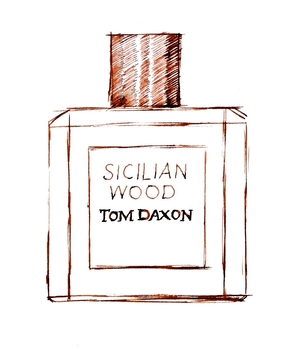 I had high hopes of Sicilian Wood. Tom Daxon launched his perfume business in March 2013 at the age of 25, and has quickly gained a lot of fans. I’m not surprised, as he looks like a nice chap and he should know his stuff: his mother, Dale Daxon Bowers, was trained as a chemist and worked for Mary Quant cosmetics before becoming creative director of Molton Brown, so you could say that Tom grew up in the fragrance business.
I had high hopes of Sicilian Wood. Tom Daxon launched his perfume business in March 2013 at the age of 25, and has quickly gained a lot of fans. I’m not surprised, as he looks like a nice chap and he should know his stuff: his mother, Dale Daxon Bowers, was trained as a chemist and worked for Mary Quant cosmetics before becoming creative director of Molton Brown, so you could say that Tom grew up in the fragrance business.
He’s started out with a small range of nine different perfumes, and as you’d hope given his background they’re outstandingly well designed and packaged, with sharp typefaces, smart faceted bottles and attractive boxes cleverly secured with criss-crossing black ribbons.
So far so good. The only trouble is, try as I might I just can’t get to like the perfume inside.
Daxon compares Sicilian Wood with ‘a citrus grove warming in the sun… [with] an effervescent, hyper-real citrus top note [that] settles into a base of seductive woods.’ He’s also described it as ‘a budget-less woody citrus [that] will prove a revelation to anyone left underwhelmed by all the bland versions out there.’
I certainly get the citrus, and the warmth, which emerges from a mix of (among other things) cardamom, guaiac wood, jasmine, cedar and sandalwood. But Sicilian Wood also has to me an unsettling, slightly sickly, somehow faintly chemical smell, which it shares with so many men’s fragrances on the market (especially so-called ‘sports’ scents) that I call it cheapone: the very opposite of ‘budget-less’, in other words.
Whatever it is, it spoils this perfume for me, which is a shame, as I’d really like to like it, not least because it was created by Carla Chabert and her father Jacques, who was once assistant to the perfumer Henri Robert at Chanel, and is said to have had a hand in Chanel’s classic Cristalle. Time to explore some of the other perfumes in the range.
Frederic Malle
Cologne Bigarade
10 January, 2015
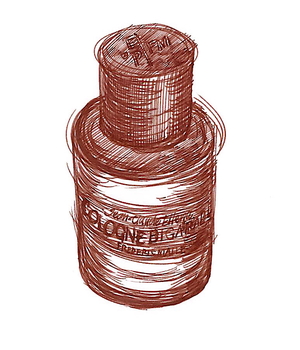 Every morning for my breakfast I have tea, toast and home-made marmalade. It’s one of my favourite things, and I love the bittersweet smell of Seville oranges, which only appear in the shops for a couple of weeks around this time of the year.
Every morning for my breakfast I have tea, toast and home-made marmalade. It’s one of my favourite things, and I love the bittersweet smell of Seville oranges, which only appear in the shops for a couple of weeks around this time of the year.
In fact as I sit here writing this post in January, Roy is busy cooking marmalade next door, and the powerful odour of bitter orange (known as bigarade in French) is suffusing the house from kitchen to attic.
So it could hardly be a better time to review Cologne Bigarade, created by the perfumer Jean-Claude Ellena for the French fragrance curator and marketeer, Frédéric Malle (nephew of the film director Louis Malle). Launched in 2001, it was one of the first of the Editions de Parfums Frédéric Malle, and to my mind it’s one of the most immediately appealing and easy to enjoy.
On first – I was going to say ‘glance’, but I suppose I should say ‘spritz’, it smells like a simple but high-quality natural scent, with the exact mix of sweet green freshness and slight bitterness that you get from orange peel and its bitter pith.
You could, I guess, just bottle Seville-orange extract and have done with it – and apparently Jean-Claude Ellena did commission a special new essence for this scent, obtained by molecular extraction. But like all good perfumes Bigarade Cologne is ultimately a clever recreation of what seems, on the surface, like a simple natural scent, using a careful balance of other ingredients to enhance and support the main ingredient.
In this case, Ellena has added a bit of hay and grass – or rather their synthesised essences – which makes the orange even fresher somehow, then subtly underpinned it with a little cedar-wood and rose, adding extra depth and staying-power. You could even say that these extra ingredients suggest the smell of the leaves and the twigs of orange trees, though perhaps that’s going too far.
(Actually, unless you concentrate very hard you can’t really smell them at all; but then we’re so suggestible when it comes to scents that once someone has told you that a particular ingredient is present, you’re more than likely to ‘smell’ it whether it’s actually there or not.)
To me Cologne Bigarade also has a very slight and not unpleasant sweatiness, which (from a short trip to the kitchen and back) is part of the authentic Seville orange smell. In perfume that faint sweatiness is often derived from cumin, and I wonder if there might be a touch of that classic curry spice here too.
Cologne Bigarade is not, perhaps, the most complex perfume on the market, but like most of Jean-Claude Ellena’s fragrances it’s rather more thoughtful and unusual than the general run. Given that he’s also the in-house perfumer for Hermès, it immediately made me think of Hermès’ classic Eau d’Orange Verte, which is also based on the scent of bitter oranges. Though that perfume was originally created by Françoise Caron in 1979, Ellena developed a new version in 2004 called Concentrée d’Orange Verte.
Eau d’Orange Verte is one of my all-time favourite fragrances, yet comparing them side by side, it smells sharper and fresher, but perhaps also slightly less interesting than Cologne Bigarade, which also seems to have much more staying power (a rare quality in a citrus-based cologne, though you can also find it in the fantastic sherbet-lemon Monsieur Balmain).
All the fragrances in the Editions de Parfums Frédéric Malle are expensive, and Cologne Bigarade is no exception, even if its packaging is extremely smart. The heavy, plain-glass bottle has a chunky black cap and comes in a slide-out, black foam-padded box, which in turn slides out (with some effort) of a scarlet card wrapper. If you have money to burn then there’s an even more expensive version called Bigarade Concentrée, which I’ve smelled as a sample and lasts even longer than Cologne Bigarade. The concentrated version also seems to have less of that faint sweatiness about it, which I suspect many people would prefer; I think I do too.
Either way, a fresh but unusual cologne is a wonderful thing to have, so full marks to Jean-Claude Ellena and Frédéric Malle for giving men something a bit different to wear. In a similar vein, though with a very different smell, is Malle’s Geranium Pour Monsieur, which I hope to be able to review before long; watch this space.
Givenchy
Givenchy Gentleman
25 October, 2014
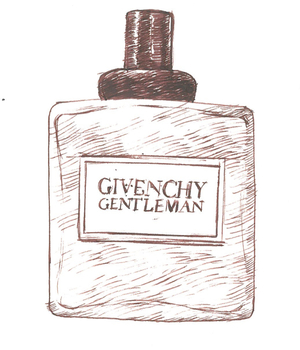
I don’t often, to be honest, feel very hippyish, but on the odd occasions when I do then Givenchy Gentleman suits my mood very well, with its distinct patchouli smell.
The original version was released in 1974 to tie in with couturier Hubert de Givenchy’s first ready-to-wear boutique, and it must have seemed bang on trend back then. Created by Paul Lèger (who also had a hand in the big-selling women’s perfume, Anaïs Anaïs), it was quickly hailed as a masterpiece, but has since been turfed out of the perfume pantheon, not least because the original recipe was fiddled about with a few years ago – presumably to save money and comply with tighter industry regulations.
If Givenchy Gentleman contained nothing but patchouli I wouldn’t be writing this review, but Lèger’s long list of ingredients included cinnamon, vetiver and something that approximates to the smell of leather. The last two in particular give the scent its appealing earthy, masculine character and stop it from being too sweet or cloying; it also contains (or contained) a whole host of other fragrance ‘notes’, including lemon and bergamot, tarragon, cedar and sandalwood, which added to Givenchy Gentleman’s complexity and depth.
It may not be the perfume that once it was, but I haven’t yet found a more wearable patchouli-based scent for men, though I have to admit that the latest version (has it been reformulated again?) starts well but then develops a slightly sour, unattractive undertone on the skin.
It’s been repackaged too, and the latest bottle has such a cheap label that if I didn’t know better I’d be inclined to suspect I’d been sold a dodgy knock-off from a market stall. Sadly it seems that the knock-off effect is entirely Givenchy’s own.